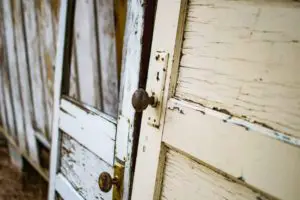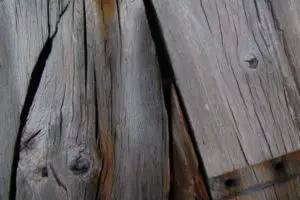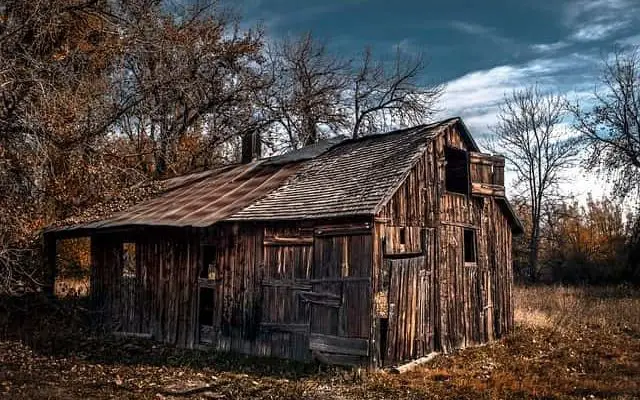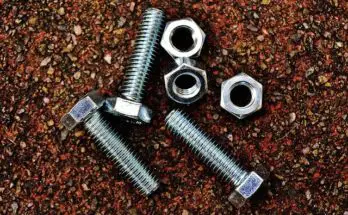In addition to the unique look, the use of barn wood is eco-friendly! Many times, you may see construction sites bulldozing an old barn and then burning the wood to get rid of it. Re-using the wood for home decor gives it a new life rather than just turning it into ashes to make way for a new shopping mall. Below we will look at how to go about finding and buying barn wood. We will also cover some of the things you need to watch for to protect yourself from using toxic woods.
Reclaimed wood vs Salvaged wood
Salvaged wood is defined as wood, lumber or logs which have never been used. Any board or piece of wood that you find that has been sitting but never been used for anything is defined as salvaged wood. You may be wondering how a board or piece of wood can be “unused” especially when its decades old. One such example is beams or boards that have been stored in a barn loft. Many older farmers in the United States grew up during or shortly after the Great Depression. Their generation made an effort to save anything they felt might have a use for later. It’s not uncommon to find wood, tools or even a car in some rare cases that have been sitting in the back of a barn for decades completely untouched.
Another fascinating example of salvaged materials being used is log recovery. Prior to trains and trucks, loggers used the nation’s waterways to transport massive amounts of logs from their forest to saw mills. Mules and Oxen were used to drag the logs across land to the closet river.
From there, the logs were pushed into the water and then floated down the river to the mill. Most logs would float. However, on occasion, a log would sink during the trip to the mill. These logs sat on the bottom of these rivers for decades. In many cases, the water ended up protecting them from decay.
Now, there are actually companies that dive to the bottom of these rivers to recover the untouched logs. The logs are then milled and sold to companies or individuals. These woods are considerably more expensive than regular salvaged wood. These preserved logs are used to make some of the most expensive violins on the market today. For additional details on this process, check out this article by the New York Times from 1997.
 Reclaimed wood is any wood that has been recovered and used in the past. Barn wood falls into this category because it’s been recovered from a barn. Reclaimed wood can be recovered from a number of sources. Some of these include old homes, schools, factories, churches and even railroad cars.
Reclaimed wood is any wood that has been recovered and used in the past. Barn wood falls into this category because it’s been recovered from a barn. Reclaimed wood can be recovered from a number of sources. Some of these include old homes, schools, factories, churches and even railroad cars.Old Growth vs New Growth
Many people don’t realize it, but there is a significant difference in old wood versus new wood that is available at hardwood stores. The difference isn’t just the age, but rather the actual structure and look of the wood. This is commonly referred to as old growth lumber and new growth lumber.
Odds are when you purchase your reclaimed lumber it is several decades old. It’s very likely that the barn it was used on was 50-100 years old. That means the lumber is 100 years old, but the tree may have been another 50-100 years old before it was cut down. Therefore, it’s very possible the reclaimed lumber you purchased came from a tree that was planted when Thomas Jefferson or Andrew Jackson was President! During that time, there were millions of acres of virgin forest.
Wood created from logs that grew in a virgin forest look much different than the wood we see at hardware stores today. The most obvious visual difference is apparent when you compare the end grains of the new and old pieces. You’ll see the rings of the old wood is much tighter and closer together. This also makes it much stronger and less likely to crack or split.
Today, when a forest has it’s lumber harvested, the logging companies replant the land as a means to replace the trees that were cut. Additional steps are also taken to make the trees grow faster and more condensed so they can be harvested again in a few decades. These additional steps are unnatural such as using man made fertilizers and over populating the land with pine trees which grow more quickly. These small changes can be significant differences for the trees as they grow.
Where to buy it?
Local Salvage Companies
Once the structure has been deconstructed, they sort the wood and transport to their shop. From there a number of things can happen. They can mill it into different shapes, remove nails or simply organize it at their business and sell as is. These businesses will generally have the best options to choose from, especially if you are looking for something specific.
Most major cities should have at least a couple of these companies in operation in their area. In my experience, these shops tend to be a bit more expensive than some of the other options we will look at. However, the companies tend to also have the best wood when it comes to structural integrity. They also tend to do a better job at ensure the boards are free of bugs. A simple search in your area should provide suitable results.
Craiglist
Local Owners
A farmer may be less willing to sell their barn to an individual if the structure is large or has serious structural issues due to liability. They also may be hesitant for fear that you will only remove the high quality boards and not everything which leaves them with a mess to clean up afterwards. If you are going to approach a landowner about removing a large structure, I highly suggest drawing up a small contract that clearly defines these details.
eBay & Etsy
Facebook Marketplace
Local Businesses (Pallet Wood)
What many people don’t realize, is that pallet wood can be toxic for your home. Fortunately, there are ways to determine if a pallet you are looking at is toxic before grabbing it to use for your project.
The next time you are around several pallets, take time to notice if any a burned stamps on them from the International Plant Protection Convention (IPPC). Pallets with their logo burned onto them indicate the pallet was used for international shipping.
It’s important to learn the what these markings are telling you about the wood before using it. The most important symbol that you want to watch for is “MB.” The “MB” symbol stands for Methyl Bromide.
This chemical is used to kill any bugs or bacteria that may be present in the wood before sending it across international waters. IT EXTREMELY IMPORTANT TO NOT USE PALLETS MARKED WITH “MB.” The cutting or burning of this wood can cause serious lung problems if inhaled.
If you come across a pallet that has no burned stamps, this indicates that it has only traveled within your specific country. Caution should still be used as there is a possibility it was treated with dangerous chemicals. My advice would be to only use pallets with stamps on them to be absolutely certain.
Gray wood vs Brown wood
Before visiting a buyer of wood decide if you have a preference on color. The first time I went to buy some reclaimed wood, I was caught off guard by this question because I didn’t know it could vary. I assumed everything was brown. It’s good to know before arriving if you need all of one particular color or a mix of both.
Things to Watch For
Lead Paint

Bugs and Insects
Dust
Strength
Nails or metal
Splinters
Milling (might) be Required
 A joiner is used to create a straight line on a piece of wood. This line is created by repeatedly running the edge of your board over the joiner bed and blades. One you have a solid straight line, you can run the board through your table saw. Simply put the straight edge against the table saw’s fence and cut your piece to width. This will give you two perfectly straight edges.
A joiner is used to create a straight line on a piece of wood. This line is created by repeatedly running the edge of your board over the joiner bed and blades. One you have a solid straight line, you can run the board through your table saw. Simply put the straight edge against the table saw’s fence and cut your piece to width. This will give you two perfectly straight edges.Next, in order to get the thickness that you desire, you’ll need to use a thickness planer. You’ll send the board through the planer repeatedly and slowly lower the blades on each pass. You should alternate each pass through the planer with each face passing over the blade. Once you have reached your desired thickness, you should have 4 perfectly square sides to you board.
Questions
Just to recap so you are prepared when you go to pick up a batch of reclaimed wood, below are a few of the most common questions you are likely to be asked. Prepare ahead of time so you are able to get exactly what your project requires!




